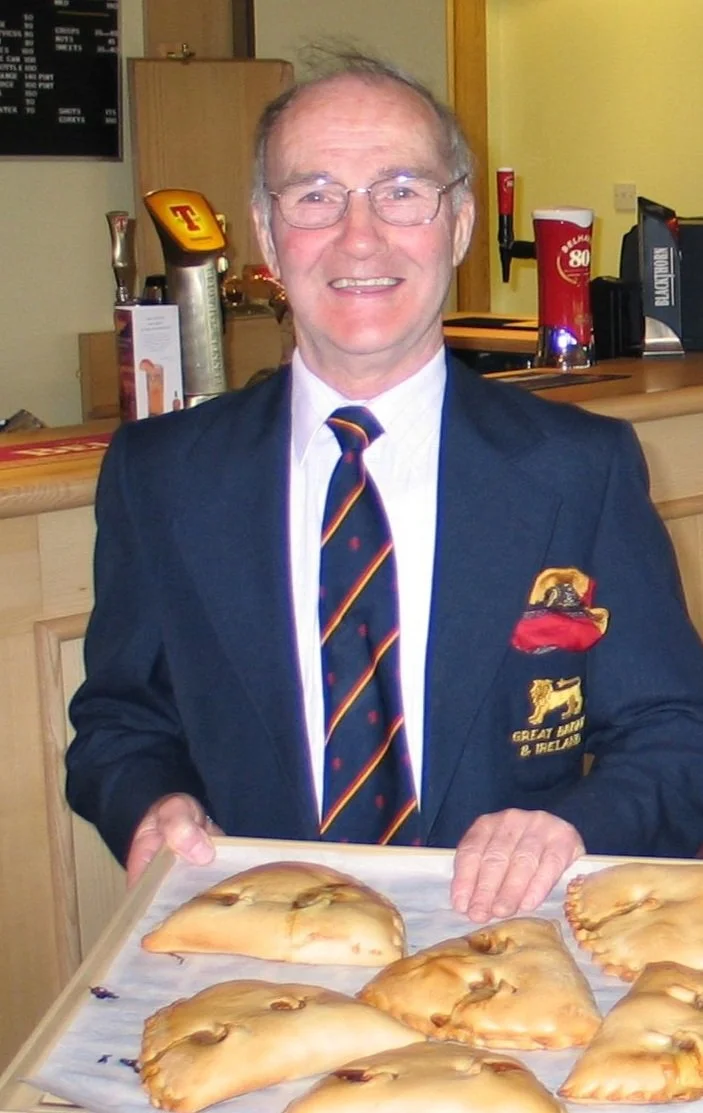Bridies, Birdies & Stone-Carved Stories
The market town of Forfar, nestled in the heart of Angus, is perhaps best known for its Bridies—a delicious, crescent-shaped meat pie filled with mince, sometimes with added onions, sometimes without. Long before global chains like McDonald’s arrived on the scene, the Bridie—and its east coast cousin, the Dundee Peh—were Scotland’s own fast-food staples, served hot from the bakery in a paper bag.
One of the most iconic purveyors of these meaty delights is Saddlers of Forfar, a long-standing bakery on East High Street. At the helm for many years was Sandy Saddler—not just a master baker, but also one of Scotland’s most accomplished amateur golfers.
Between 1959 and 1967, Sandy represented Great Britain in golf 14 times and Scotland on 22 occasions. He was the only GB player to win both of his singles matches in the 1967 Walker Cup, and captained the team a decade later in 1977. At home, he was a seven-time club champion at Forfar Golf Club, a course that clearly shaped his game—and vice versa.
I had the pleasure of meeting Sandy years ago, when I brought a group of golf writers to explore Angus. He shared tales from his storied career, including the time he was hired to teach the Sultan of Brunei how to play golf. Tempted to stay in that oil-rich paradise, Sandy ultimately returned to Forfar, following his father’s advice to run the family bakery.
Fittingly, Forfar Golf Club recently honoured its most distinguished member by naming its main lounge after him.
Where Does the ‘Bridie’ Come From?
Interestingly, the name “Bridie” may be rooted in ancient Celtic. It’s associated with meanings like “exalted one,” “fire goddess,” “strength,” and “virtue.” Whether it’s named for the bride who may have once favoured it as a wedding-day snack, or for something more mythical, the Forfar Bridie remains an East Coast culinary icon.
From Pies to Punishment
Not all Forfar artefacts are as comforting. On display at the Meffan Museum on West High Street is the grimly named Forfar Bridle—a cruel iron device once used to silence and restrain women accused of witchcraft before execution. It's a stark reminder of the darker chapters in Scotland's history.
Industry and Heritage
Historically, Forfar thrived as a jute and flax milling centre, benefitting from its proximity to Dundee—the global heart of the jute trade. Today, the town’s economy has shifted toward synthetic textiles and agriculture-related industries, but the legacy of its industrial past remains woven into its character.
Landlocked Links
Just east of town on the A932 lies Forfar Golf Club, one of the oldest 18-hole inland courses in the world. Its undulating fairways mimic those of true links terrain, thanks to the land's prior use for drying flax—stacked in rows that shaped the ground into long, grassy swells. Designed by Old Tom Morris and later reworked by James Braid, the course remains a satisfying test for golfers of all levels.
Ancient Stones at Aberlemno
Just six miles (10 km) northeast of Forfar on the B9134, the Aberlemno Sculptured Stones offer a fascinating glimpse into Pictish history. The first of these intricately carved standing stones stands in the village churchyard, while three more line the roadside further up the hill. These early medieval stones are often described as "Pictish storybooks in stone," preserving myths, battles, and symbols from a people whose language and legacy still stir the imagination.
From piping-hot Bridies to Pictish stones, from golfing legends to grim relics of Scotland’s past, Forfar is a town rich in character and contrast—well worth a stop for the curious traveller or hungry golfer.

